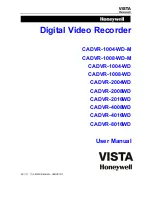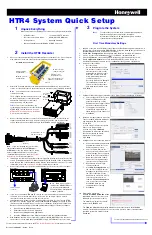
User’s Manual
2
Technical Overview
Your DVR can replace both a time-lapse VCR and a multiplexer in a security installation.
However, it has many features that make it much more powerful and easier to use than even the
most advanced VCR.
The DVR converts analog NTSC or PAL video to digital images and records them on a hard
disk drive. Using a hard disk drive allows you to access recorded video almost instantaneously;
there is no need to rewind tape. The technology also allows you to view recorded video while
the DVR continues recording video.
Digitally recorded video has several advantages over analog video recorded on tape. There is
no need to adjust tracking. You can freeze frames, fast forward, fast reverse, slow forward and
slow reverse without image streaking or tearing. Digital video can be indexed by time or events,
and you can instantly view video after selecting the time or event.
Your DVR can be set up for event or time-lapse recording. You can define times to record, and
the schedule can change for different days of the week and user defined holidays.
The DVR can be set up to alert you when the hard disk drive is full, or it can be set up to record
over the oldest video once the disk is full.
Your DVR uses a proprietary encryption scheme making it nearly impossible to alter video.
You can view video and control your DVR remotely by connecting via modem or Ethernet. A
standard PostScript™ computer printer can be connected to the DVR to print frame captures.
There is a USB port that can be used to archive video to external hard disk drives. (Network
model only.)
NOTE: This manual covers the 4-, 9- 16-channel digital video recorders. The DVRs are
identical except for the number of cameras and alarms that can be connected and the number
of cameras that can be displayed. For simplicity, the illustrations and descriptions in this
manual refer to the 16-camera model.
There are several versions of each model. If the model number includes an “E,” the DVR does
not have network features. The numbers after the hyphen indicate the storage capacity. For
example, an AHDR9E-160 is a 9-channel unit that has 160GB of storage capacity and does not
have network features. The following units are available:
System Series (Networkable)
4 Channel
9 Channel
16 Channel
AHDR4-80
AHDR9-80
AHDR16-80
AHDR4-160 AHDR9-160 AHDR16-160
AHDR4-320 AHDR9-320 AHDR16-320
E Series (No Network Features)
4 Channel
9 Channel
16 Channel
AHDR4E-80
AHDR9E-80
AHDR16E-80
AHDR4E-160
AHDR9E-160
AHDR16E-160
AHDR4E-320
AHDR9E-320
AHDR16E-320
Summary of Contents for AHDR16
Page 1: ......
Page 3: ...User s Manual ii...
Page 83: ...User s Manual 72 Appendix E Map of Screens...
Page 91: ......














































